The Sauce Making Machine Market is estimated to be valued at USD 1.1 billion in 2025 and is projected to reach USD 2.0 billion by 2035, registering a compound annual growth rate (CAGR) of 6.0% over the forecast period.
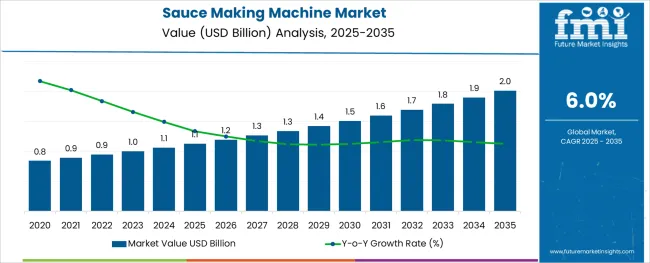
The sauce making machine market is demonstrating consistent growth as automation, hygiene standards, and demand for high throughput drive investments in modern food processing equipment. The market is being influenced by the rising preference for efficient, reliable, and easy-to-clean machines that align with global food safety norms and increasing production requirements.
Manufacturers are focusing on developing machines that enhance productivity while minimizing energy consumption and maintenance costs. Future growth is expected to benefit from the adoption of smart manufacturing practices, rising demand for customized sauce formulations, and growing investments by small and medium enterprises upgrading their facilities.
Continuous innovation in design and integration of digital controls are paving the way for higher operational efficiency and scalability, making these machines indispensable in both artisanal and large-scale food production environments.
The market is segmented by Type, Mode of Operation, and Sales Channel and region. By Type, the market is divided into Sauce Stirring Machine, Sauce Fermentation Machine, and Other Types. In terms of Mode of Operation, the market is classified into Fully Automatic and Semi Automatic. Based on Sales Channel, the market is segmented into Direct Sales and Retail Sales. Regionally, the market is classified into North America, Latin America, Western Europe, Eastern Europe, Balkan & Baltic Countries, Russia & Belarus, Central Asia, East Asia, South Asia & Pacific, and the Middle East & Africa.
The market is segmented by Type, Mode of Operation, and Sales Channel and region. By Type, the market is divided into Sauce Stirring Machine, Sauce Fermentation Machine, and Other Types. In terms of Mode of Operation, the market is classified into Fully Automatic and Semi Automatic. Based on Sales Channel, the market is segmented into Direct Sales and Retail Sales. Regionally, the market is classified into North America, Latin America, Western Europe, Eastern Europe, Balkan & Baltic Countries, Russia & Belarus, Central Asia, East Asia, South Asia & Pacific, and the Middle East & Africa.
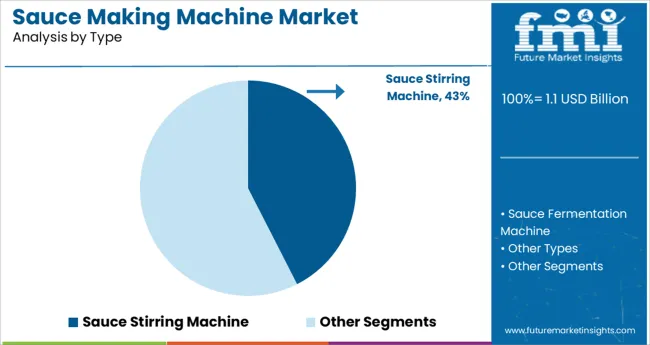
When segmented by type, the sauce stirring machine is projected to contribute 42.5% of the total market revenue in 2025, positioning it as the leading type segment. This dominance is attributed to its critical role in ensuring consistency, preventing burning, and achieving uniform texture in sauce production.
Its ability to handle high viscosity materials and operate continuously without compromising quality has made it indispensable in both small and large kitchens. Improvements in blade design, heat distribution mechanisms, and user-friendly controls have further enhanced its efficiency and appeal.
The preference for this type has also been supported by its versatility to handle a wide range of sauce recipes, improving operational flexibility and reducing downtime between production batches.
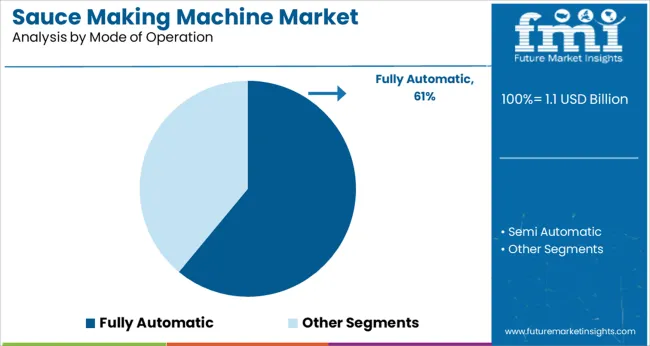
In terms of mode of operation, fully automatic machines are expected to account for 61.0% of the market revenue in 2025, establishing themselves as the dominant mode. This leadership has been reinforced by the growing demand for consistent output, labor cost reduction, and compliance with strict hygiene regulations.
Fully automatic machines offer seamless integration of multiple functions including mixing, heating, sterilizing, and filling, which significantly enhances productivity and minimizes human intervention. Advanced control systems and programmable logic controllers have enabled precise monitoring and adjustment of parameters, further increasing reliability and reducing wastage.
The ability of these machines to deliver standardized results at scale has made them the preferred choice among commercial sauce manufacturers seeking to optimize operations and maintain product quality.
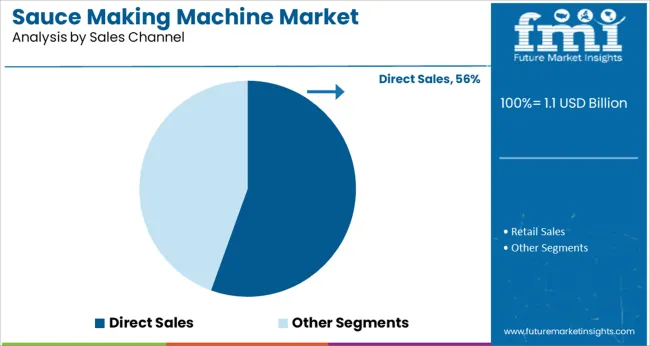
Segmented by sales channel, direct sales are forecast to hold 55.5% of the market revenue in 2025, making it the leading channel. This prominence is driven by the close engagement between manufacturers and buyers, which facilitates customization, better service, and long-term support.
Direct sales allow customers to receive tailored solutions and technical guidance, fostering trust and ensuring the machine specifications meet their exact production needs. The ability to negotiate directly, along with access to after-sales maintenance and training, has further reinforced customer preference for this channel.
Manufacturers have also benefited from stronger brand loyalty and improved understanding of customer requirements through direct interactions, which has contributed to the sustained dominance of this sales approach.
By 2035, the sauce making machine market is predicted by FMI to reach over USD 1.1 billion. In the first half of 2025, the global market increased at a CAGR of 7.6% which is the market share valued at USD 1.1 billion. Though not equally distributed throughout all regions, this growth is stronger in developing markets, where it is predicted to reach at the end of 2025 valued at USD 1 billion with a CAGR of 6%.
Based on the type of machine, the market is segmented as semi-automatic and fully automatic. Recent research has shown that the semi-automatic machine has grown at a CAGR of 7.2% in the year 2020 to 2024. The market registered a CAGR of 5.8% in the forecasted period.
Sauce Making Market:
| Attributes | Sauce Making Market |
|---|---|
| CAGR (2025 to 2035) | 6% |
| Market Value (2035) | USD 2.0 billion |
| Growth Factor | With the growing popularity of fast food and botanical flavors, the demand for machines is increasing. |
| Opportunity | The growing number of expatriates and the willingness of the natives to try new cuisines have increased the demand for sauces |
| Key Trends | Increasing innovation in the processed foods segment regarding sauce making machines and the emergence of a new food service sector |
Plant-based Food Market:
| Attributes | Plant-based Food Market |
|---|---|
| CAGR(2025 to 2035) | 11.7% |
| Market Value(2035) | USD 16.35 billion |
| Growth Factor | Several food industry pioneers have launched products in this segment and there has been a growing awareness of the health and environmental benefits of plant-based foods over animal-based foods. |
| Opportunity | Increasing consumer interest in healthier food alternatives to animal-based products and diverse ingredients |
| Key Trends | Vegan restaurants are becoming more popular as consumers become more health conscious. |
Tomato Processing Machine Market:
| Attributes | Tomato Processing Machine Market |
|---|---|
| CAGR(2025 to 2035) | 3.6% |
| Market Value(2035) | USD 1.55 billion |
| Growth Factor | Fast food is one of the fastest-growing markets, and in addition to the growth of the organized retail sector, the expansion of the market of fast food is expected to contribute further to its growth. |
| Opportunity | The popularity of tomato products has grown as consumers have become accustomed to tomato flavor and taste. |
| Key Trends | In conjunction with the westernization of food patterns, rapid globalization is also contributing significantly to increasing growth. |
Foods that are Processed are in High Demand
There is an increase in the manufacturing of processed foods that drives the market in developing nations. Moreover, the urban population of these nations is likely to have a positive impact on the demand for processed foods, which, in turn, drives the market for sauce making machines.
With the growing popularity of fast food, particularly among the young generation, processed products such as sauces are in high demand. This may lead to the growth of the market across the board as the market grows.
The Rise in Demand for Botanical Flavours
Globally, the demand for international cuisine is on the rise, and the shift in consumer focus from conventional to natural products as well as a rise in demand for botanical flavors all contribute to the growth of the international cuisine market.
Further, millennials are increasingly spending more on experimenting with different cuisines, flavors, and textures which leads to a rise in the demand for sauces and condiments. Additionally, new aromas and flavors are developed for the food and beverage industries through the use of herbs and sauces and condiments.
Available on Different Sales Channels
Various platforms, such as modern trade and online sales channels, are available through which sauces & condiments can be purchased and sold, resulting in an expansion of the global market for these products.
As a result, the market is expected to grow in terms of retail sales over the next few years due to the increase in penetration. Additionally, the availability of sauces and condiments on e-commerce platforms results in consumers being able to purchase goods without physical constraints.
In the sauce making machines market, there is a huge opportunity for various sauce varieties to be developed, which will enhance the sales of the machines. There is an increasing demand for new flavors in the market as well as the introduction of various variants of sauces like honey-mustard sauces and mustard-mayonnaise sauces.
Today, vendors are taking advantage of the increasing demand for new flavors in the market to address the increasing demand for these flavors. In addition, many vendors have started integrating more natural ingredients into their products after displaying a growing interest in organic and natural food products among consumers in recent years. As a result, vendors in the market can focus on offering various types of machines, allowing customers to try out different sauce varieties.
According to the report, it has been identified that the sauce making machine has been segmented into different types and the sauce fermentation machine has accounted for a significant share of the market during the base period.
It is estimated that during the base period of 2020 to 2025, the sauce fermentation machine market may grow at a CAGR of 7.9%, and in the forecasted period, the market is projected to grow at a CAGR of 6.3% at a substantial rate.
The reasons attributing to the steady advancement of the sauce fermentation machine market are identified as follows:
The sauce making machine's most recognized mode of operation is semi-automatic, and it accounts for major shares during the base year. A CAGR of 7.2% is expected to be achieved during the base period of 2020 to 2024 while it is predicted to grow at a CAGR of 5.8% in the mode of operation segment during the forecast period.
The North American market remains the largest consumer of sauces in the world due to the increasing adoption of diverse foods among consumers in the region. The United States is one of the major markets in the region that utilizes a great deal of sauce making machinery in the food service sector, as well as packaged foods, to meet the demand for Asian foods in the market, mainly because it is a major market in the region. Furthermore, as a result of the increasing numbers of people moving to the country from different parts of the world, there is also a huge increase in the need for accommodation.
Currently, Asia Pacific is leading the way in the market, as exemplified by the fact that it is one of the biggest producers as well as consumers of sauce throughout the world. Growth is primarily due to China, as it has been a traditional condiment since ancient times.
Through the development of society & the advancement of technology, several innovative sauces have been developed and have been fueling the market for their consumption over the last few decades. Every year, China imports more than 50 MMT of soybeans, out of which it produces this sauce to meet the demand-supply gap in the market.
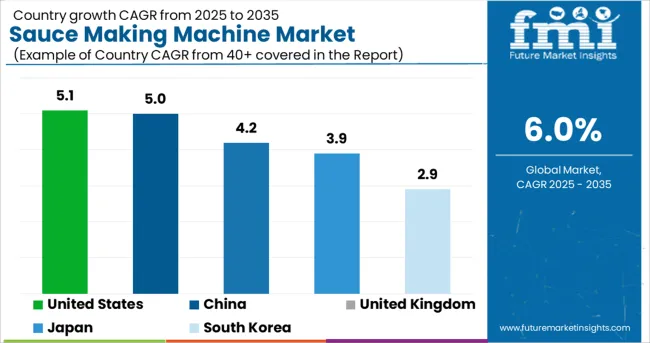
| Countries | Statistics |
|---|---|
| United States | The sauce making machine market in the USA currently holds the maximum number of shares and has registered a market valuation of USD 1.1 million in 2025. The market is projected to reach a valuation of USD 2 million by the end of 2035. CAGR for 2025 to 2035: 5.1% Historical CAGR (2020 to 2025): 7.3% |
| United Kingdom | Europe is identified to hold a significant market share in the sauce-making machine market. Currently, the United Kingdom is the leading country in this region and is accountable for a market valuation of USD 23.8 million in 2025, advancing at a moderate-paced CAGR of 4.2%. The market valuation is expected to surpass USD 70.6 million by 2035. Historical CAGR (2020 to 2025): 6.2% |
| China | China is projected to advance at a rapid pace, registering a CAGR of 5% through the forecast period. The country is currently holding a market valuation of USD 47.1 million in 2025.FMI estimates valuation to surpass USD 122.7 million by the end of 2035. Historical CAGR (2020 to 2025): 6.8% |
| Japan | Japan is projected to advance at a moderate pace, registering a CAGR of 3.9% through the forecast period. The country is currently holding a market valuation of USD 31 million in 2025.FMI estimates valuation to surpass USD 98.2 million by the end of 2035. Historical CAGR (2020 to 2025): 5.7% |
| South Korea | The Korean sauce-making machine market is anticipated to advance at a slow-paced CAGR of 2.9% during the forecast period. At present, the market is holding a valuation of USD 14 million in 2025. The analysts at FMI have projected a market value of USD 56.5 million by 2035. Historical CAGR (2020 to 2025): 5% |
The Market is Fragmented with New Players as the Number of Local Players is Increasing
As a result of the presence of several dominant players in the global market, the overall structure of the market is moderately organized. There are many manufacturers of sauce making machines that are focusing their efforts on the production of innovative and advanced machines to keep up with the prevailing trend in this industry.
As the market for sauce making machines grows, there are an increasing number of new companies entering the market. These companies are leveraging technological advances to offer improved products that take advantage of the market as it continues to grow. By introducing enhanced offerings, companies aim to gain a competitive advantage.
Investing in research and development activities is essential for these companies to stay abreast of consumer preferences and the demands of the end-use industries in order to remain competitive. Efforts are being made to strengthen their foothold in the industry. This will allow them to increase their visibility within the forum. In addition, it will help enhance the further development of the sauce making machine by enhancing their visibility within the forum.
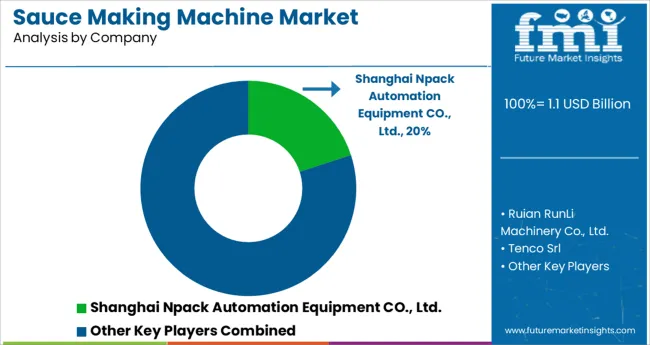
Key players operating the global sauce making machine market include
Key Developments for Sauce Making Machine Market
| Attribute | Details |
|---|---|
| Forecast Period | 2025 to 2035 |
| Historical Data Available for | 2020 to 2025 |
| Market Analysis | billion for Value and MT for Volume |
| Key Regions Covered | North America; Latin America; Europe; East Asia; South Asia; Oceania; and the Middle East & Africa |
| Key Countries Covered | USA, Canada, Brazil, Mexico, Chile, Peru, Germany, United Kingdom, Spain, Italy, France, Russia, Poland, China, India, Japan, Australia, New Zealand, GCC Countries, North Africa, South Africa, and Turkey |
| Key Segments Covered | Type, Mode of Operation, Sales Channel, Region |
| Key Companies Profiled | Shanghai Npack Automation Equipment CO., Ltd; Ruian RunLi Machinery Co., Ltd.; Tenco Srl; Cankey Technology Co., Ltd; APACKS; S.K. Industries |
| Report Coverage | Market Forecast, Company Share Analysis, Competition Intelligence, DROT Analysis, Market Dynamics and Challenges, and Strategic Growth Initiatives |
| Customization & Pricing | Available upon Request |
The global sauce making machine market is estimated to be valued at USD 1.1 billion in 2025.
It is projected to reach USD 2.0 billion by 2035.
The market is expected to grow at a 6.0% CAGR between 2025 and 2035.
The key product types are sauce stirring machine, sauce fermentation machine and other types.
fully automatic segment is expected to dominate with a 61.0% industry share in 2025.






Full Research Suite comprises of:
Market outlook & trends analysis
Interviews & case studies
Strategic recommendations
Vendor profiles & capabilities analysis
5-year forecasts
8 regions and 60+ country-level data splits
Market segment data splits
12 months of continuous data updates
DELIVERED AS:
PDF EXCEL ONLINE
Sauces and Condiments Market Size and Share Forecast Outlook 2025 to 2035
Sauces, Dressings, And Condiments Market Size and Share Forecast Outlook 2025 to 2035
Hot Sauce Market Size and Share Forecast Outlook 2025 to 2035
Hot Sauce Powder Market Analysis by Sauces, Dips, Soups, Convenience Food Products and other Applications Through 2035
Fish Sauce Market Growth - Culinary Trends & Industry Demand 2025 to 2035
Pasta Sauces Market Size and Share Forecast Outlook 2025 to 2035
Chili Sauce Market Size and Share Forecast Outlook 2025 to 2035
Vegan Sauces Market - Trends & Forecast 2025 to 2035
Tomato Sauce Concentrate Market Size and Share Forecast Outlook 2025 to 2035
Oyster Sauce Market Report – Demand, Trends & Industry Forecast 2025-2035
Culinary Sauce Market
Demand for Sauces, Dressings, and Condiments in Europe Outlook - Share, Growth & Forecast 2025 to 2035
Vegan Fish Sauce Market Growth - Sustainable Umami Alternatives 2025 to 2035
Vegan Pasta Sauce Market Expansion - Dairy-Free & Plant-Based Sauces 2025 to 2035
Vegan Cheese Sauce Market Size and Share Forecast Outlook 2025 to 2035
Bag Making Machine Market Size and Share Forecast Outlook 2025 to 2035
Brick Making Machines Market Size and Share Forecast Outlook 2025 to 2035
Paper Making Machines Market
Flakes Making Machine Market Size and Share Forecast Outlook 2025 to 2035
Popcorn Making Cart Market Growth - Demand & Forecast 2025 to 2035

Thank you!
You will receive an email from our Business Development Manager. Please be sure to check your SPAM/JUNK folder too.
Chat With
MaRIA